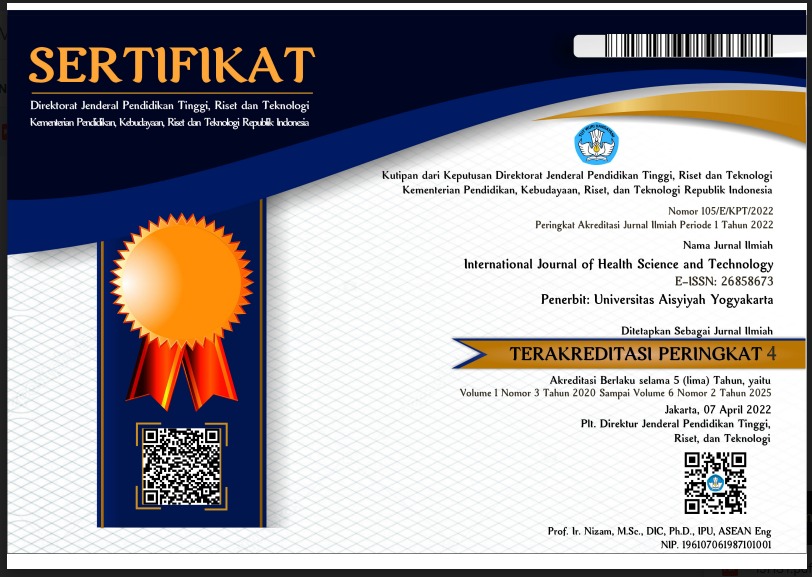Analysis of Fatty Acids in Breastmilk During a 9-month Lactation Period Using Gas Chromatography–Mass Spectroscopy (GC-MS)
DOI:
https://doi.org/10.31101/ijhst.v2i1.1830Abstract views 957 times
Keywords:
breastmilk, fatty acids, lactation periodAbstract
References
Aryani, Titin, dan Fitria Siswi Utami. 2017. Identifikasi Asam Lemak Omega Pada Breastmilk Eksklusif Menggunakan Kromatografi GC-MS. JHeS. 1(1): 1–7.
Babycentre Medical Advisory Board. 2014. Extension Breastmilk. January. http://www.lalecheleague.org/nb/nbextension.html.
Bertino E, Giribaldi M, Baro C, Giancotti V, Pazzi M, Peila C, Tonetto P, Arslanoglu S, Moro GE, Cavallarin L, Gastaldi D. 2013. Effect of prolonged refrigeration on the lipid profile, lipase activity, and oxidative status of breastmilk. JPGN. 56(4):390–396. doi: 10.1097/MPG.0b013e31827af155.
Brenna JT, Salem N Jr, Sinclair AJ, Cunnane SC. 2009. [alpha]-Linolenic acid supplementation and conversion to n-3 long-chain polyunsaturated fatty acids in humans. Prostaglandins, Leukotrienes and Essential Fatty Acids(PLEFA). 80:85–91.
Del Prado, M.; Villapando, S.; Elizondo, A.; Rodrignez, M.; Demmelair, H.; Koletzko, B. Contribution of dietary and newly form arachidonic acid to human milk lipids in women eating a low-fat diet. Am. J. Clin. Nutr. 2001, 74, 242–247.
Diana, Fivi Melva. 2013. Omega 3 Dan Kecerdasan Anak.J.Kesehatan Masyarakat. 7 (2): 82–88.
Edmond, Karen M Zandoh, Charles Quigley, Maria A Amenga-etego, SeebaOwusu-agyei, Seth. 2015. Delayed Breastmilk Initiation Increases Risk of. Doi:10.1542/peds.2005-1496.
Engler MM, Engler MB, Kroetz DL, Boswell KD, Neeley E, Krassner SM.1999. The effect of a diet rich in docosahexaenoic acid on organ and vascular fatty acid composition in spontaneously hypertensive rats. Prostaglandin, Leukotrienes, and Essential Fatty Acids (PLEFA). 61(5):289-295.
Finley DA, Lonnerdal B, Dewey KG, Grivetti LE. 1985. Breastmilk composition: fat content and fatty acid composition in vegetarians and non-vegetarians. Am J Clin Nutr.41:787–800.
Forsyth JS, Willatts P, Agostoni C, Bissenden J, Casaer P, Boehm G. 2005. Long chain polyunsaturated fatty acid supplementation in infant formula and blood pressure in later childhood: follow up a randomised controlled trial. Br Med J. 326 (7396):953.
Gao Y, Zhang J, Wang C, Li L, Man Q, Song P, Meng L, Lie O Froyland L. 2013. The fatty acid composition of colostrum in three geographic regions of China. Asia Pac J Clin Nutr. 22 (2):276-282.
Guo, M. Breastmilk Biochemistry and Infant Formula. In Manufacturing Technology; Elsevier: Cambrdige, UK, 2014.
Herrera, E. Implication of dietary fatty acids during pregnancy on placental, fetal and postnatal development—A review. Placenta 2002, 23, S9–S19.
Horta BL, Bahl R, Martines JC, Victora CG. 2007. Evidence on The Long-Term Effects of Breastmilk : Systematic Reviews And Meta Analyses. USA: WHO.
Igbal, M. 2010. Pengaruh Suhu dan Lama penyimpanan terhadap Kualitas Gizi pada Air susu ibu (breastmilk) (BREASTMILK). Skripsi. Yogyakarta : Program Studi Gizi Kesehatan UGM.
Janet et al, The Effects of Fish Oil Supplementation in Pregnancy on Breastmilk Fatty Acid Composition Over the Course of Lactation: A Randomized Controlled Trial. Pediatric Research. Vol. 62, No. 6, 2007.
Joardar, A.; Sen, A.K.; Das, S. Docosahexaeoic acid facilitates cell maturation and beta-adrenergic transmission in astrocytes. J. Lipid Res. 2006, 47, 571–581.
Kelishadi R, Hadi B, Iranpour R, Khosravi-Darani K, Mirmoghtadaee P, Farajian S, Poursafa P. 2012. A study on lipid content and fatty acid of breastmilk and its association with mother‟s diet composition. J Res Med Sci. 17(9):824–827.
Kovacs A, Funke S, Marosvolgyi T, Burus I, Decsi T. 2005. Fatty acids in earlybreastmilk after preterm and full-term delivery. J Pediatr Gastroenterol Nutr. 41:454–459.
Makela J, Linderborg K, Niinikoski H, Yang B, Lagstro H .2013. Breastmilk fatty acid composition differs between overweight and normal weight women: the STEPS Study. Eur J Clin Nutr. 52:727–735. DOI 10.1007/s00394-012-0378-5.
Makrides, M.; Nenmann, M.A.; Gibson, R.A. Effect of maternal docosahexaenoic acid (DHA) suppplementation on breastmilk composition. Eur. J. Clin. Nutr. 1996, 50, 352–357.
Marangoni F., Agostoni C., Lammard A.M., Giovannini M., Galli C. & Riva E. 2000. Polyunsaturated fatty acid concentrations in human hindmilk are stable throughout 12-months of lactation and provide a sustained intake to the infant during exclusive breastmilk: an Italian study. Br J Nutr .84:103–109
Martin MA, Lassek WD, Gaulin SJC, Evans R,Woo JG, Geraghty SR, Davidson BS, Morrow AL, Kaplan HS, Gurven MD. 2012.Fatty acid composition in the mature milk of bolivian forager-horticulturalists: controlled comparisons with a us sample. Lactating women and Child Nutrition. 8:404–418.
Milligan LA, Rapoport SI, Cranfield MR, Dittus W, Glander KE, Oftedal OTet al. 2008. Fatty acid composition of wild anthropoid primate milks.Comp Biochem Phys B. 149:74–82.
Downloads
Published
How to Cite
Issue
Section
License
International Journal of Health Science and Technology allows readers to read, download, copy, distribute, print, search, or link to its articles' full texts and allows readers to use them for any other lawful purpose. The journal allows the author(s) to hold the copyright without restrictions. Finally, the journal allows the author(s) to retain publishing rights without restrictions
- Authors are allowed to archive their submitted article in an open access repository
- Authors are allowed to archive the final published article in an open access repository with an acknowledgment of its initial publication in this journal

This work is licensed under a Creative Commons Attribution-ShareAlike 4.0 Generic License.










